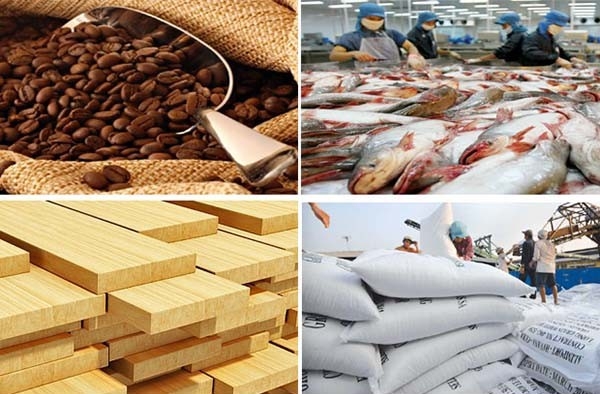VNHN - The expanded export market, the export revenues hitting record high with US$40.02 billion, and the promotion of domestic consumption are the bright spots of Vietnam’s agricultural sector throughout 2018, which also witnessed the highest agricultural growth rate over the past seven years.

Vietnam earns approximately US$40.02 billion from agro-forestry and fishery exports in 2018
GDP of agriculture, forestry and fishery highest in seven years
According to a report by the Ministry of Agriculture and Rural Development (MARD), the major aggregate targets of the agricultural sector in 2018 exceeded the whole-year plan and were higher than that of the previous year. Specifically, the gross domestic product (GDP) of agriculture, forestry and fishery expanded by 3.76% to reach the highest level in the last seven years, while the production value increased by 3.86%. Forest coverage hit 41.65%. The export revenues of the sector stood at US$40.02 billion, resulting in a trade surplus of US$8.72 billion. The 10 commodity groups with export turnover of over US$1 billion continued to be maintained, of which five items posted a revenue of more than US$3 billion, including wood and wood products (US$8.86 billion), shrimp (US$3.59 billion), fruit and vegetable (US$3.81 billion), coffee (US$3.46 billion) and cashew nuts (US$3.43 billion).
The production structure continued to be adjusted in a more appropriate and effectively fashion, in association with the market demand. There appeared many models of vegetable, flower and fruit production applying high technology and organic technologies, bringing about an income five times higher than rice production. The value of crop production increased by 2.52%, higher than the set target (2.5%).
In the field of animal husbandry, some livestock products were initially exported, such as frozen pork to Myanmar through official channels, and chicken meat to Japan. The livestock production value surged by 3.98%, higher than the set target (2.1%).
The fisheries sector reaped continuous success in 2018, with the total output reaching 7.74 million tonnes, up 6.1%, of which the proportion of high value products increased sharply, with shrimp hitting approx. 800,000 tonnes, up 7.1%, and tra fish (pangasius) at around 1.426 million tonnes, up 11.1%.
The forestry sector has cleared the international market for the exports of timber and forest products, as Vietnam and the European Union (EU) officially signed the Voluntary Partnership Agreement on Forest Law Enforcement, Governance and Trade (VPA/FLEGT). The value of forestry production expanded by 6.1%.
The capabilities of the agriculture-forestry-fishery processing industry continued to be strengthened towards intensive processing. In 2018, there were 16 modern vegetable, pork, and poultry processing factories put into operation across the country with a total investment of about VND8.7 trillion (US$374.1 million).
The consumption market for agricultural products was expanded, with the exports reaching a new record and the domestic consumption boosted. The sector paid due attention to removing difficulties and obstacles in terms of the market, especially the in major markets and regarding the products such as beef and milk into Malaysia; pork, chicken and eggs into Singapore; pork, milk, seafood and rice into China; chicken meat into Japan; frozen pork into Myanmar; star apple into the United States; rambutan into New Zealand; and lemons into the EU.
Difficulties remain
Addressing a recent conference to review the sector’s performance in 2018 and deploy tasks for 2019, MARD Minister Nguyen Xuan Cuong stated that despite multiple bright spots in last year’s agriculture picture, there remain numerous challenges to Vietnam’s agricultural and rural area development. Specifically, the consumption market is increasingly fluctuating with potential risks, while the capabilities of forecasting supply and demand are still limited, with the “rescue” of pork being a profound lesson. The issue of removing the European Commission’s “yellow card” against Vietnam’s fishing has yet to be definitively addressed, alongside the other issues, including the adverse prices of industrial crops, the potential outbreak of epidemics on plants and animals, and food safety management.
Proposing some directions for the new year 2019, Cuong said that the agricultural sector will strive to build smart agriculture with international integration and climate change adaptation, in addition to increasing the added value and facilitating sustainable development, associated with building prosperous and civilised new-style rural areas.
Specifically, in 2019, the whole sector strives to achieve a GDP growth rate of over 3%, an increase of over 3.11% in the production value, an export turnover of about US$42-43 billion, and a forest coverage rate of over 41.85%.
In order to achieve the set goals, MARD will continue to restructure the sector and boost production and processing, develop the consumption market for farm produce, and promote sustainable growth. Accordingly, the field of cultivation strives to achieve a production value growth of 1.75-1.78% and a minimal export revenue of US$20.5 billion. The livestock area strives to attain a production value increase of 3.95-4.15%. The fishery sector targets a 4.25-4.69% surge in production value and an export turnover of US$10.5 billion. The forestry sector targets forest coverage of over 41.85%, alongside a production value rise of more than 6% and an export turnover of US$10.5 billion.
Furthermore, the ministry will develop the consumption market across the country as well as the export markets, actively implement trade promotion, effectively tap into the opportunities of free trade agreements (FTAs), improve the quality of market analysis and forecast, especially the key markets, and focus on negotiating and removing barriers to the exports of agricultural products. Efforts will also be made to boost consumption in the domestic market, while forecasting and developing plans to support the timely consumption of farm produce for the people.
Agricultural sector must evoke national aspirations
Speaking at the conference, Prime Minister Nguyen Xuan Phuc highly appreciated the efforts made by the entire agricultural sector. He asked the sector to evoke the aspirations of the nation and strive to enter the group of 15 largest agricultural nations in the world in ten years’ time. Vietnam must become a wood processing centre of the world and one of the top shrimp producers globally, he said, insisting that the agricultural growth in 2019 must reach at least 3%, while agricultural exports hit approximately US$43 billion.
The Government leader asked for more drastic agricultural restructuring, including the national flagship products and local specialties, in addition to analysing and researching new markets, and building the Vietnamese brand from rice, shrimp, and fish.
He also urged for strengthening the application of science and technology, artificial intelligence and Big Data in agricultural development, the processing industry and farm produce preservation, while carrying on with the building of new-style rural areas, with an emphasis put on the criteria of income and improving people’s lives./.





